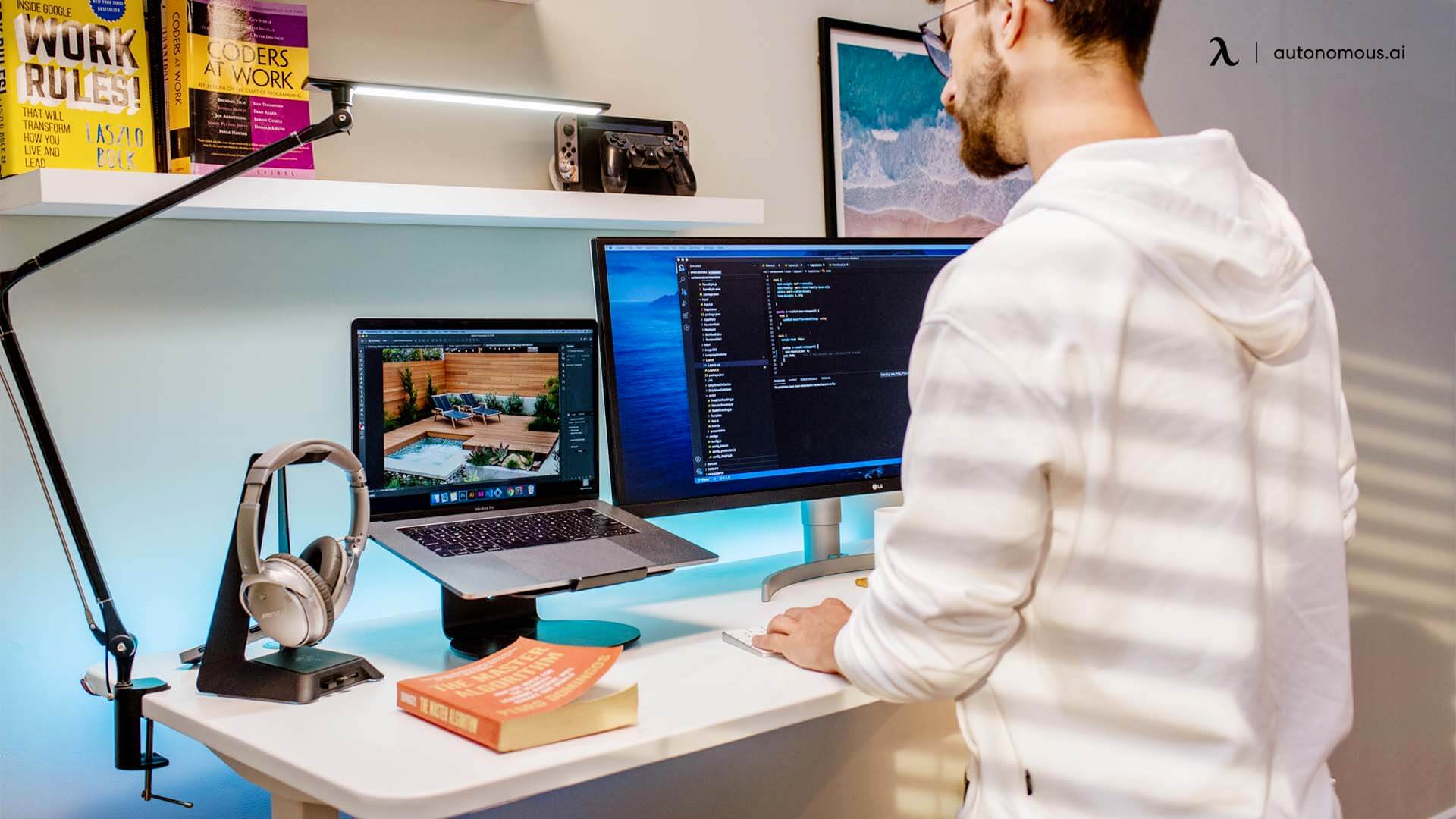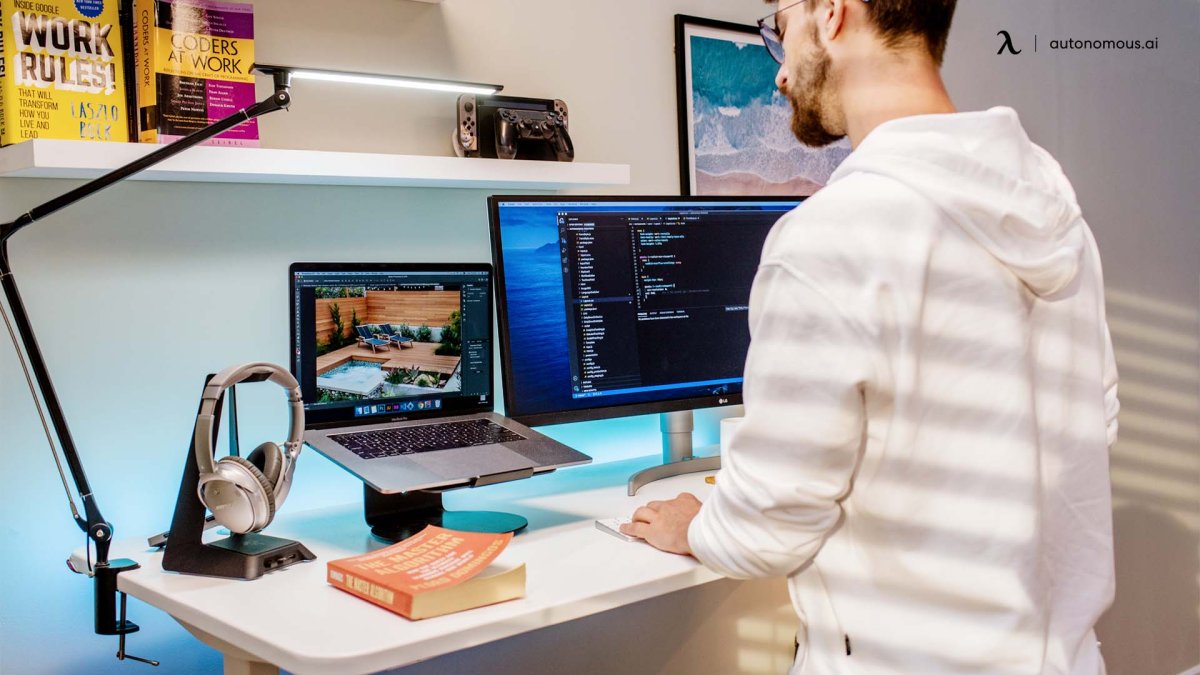
Standing desks, or height-adjustable desks, have gained popularity as healthier alternatives to traditional sitting desks. These desks promote a dynamic work environment where you can switch between sitting and standing, enhancing productivity and improving health. Proper ergonomic setup is essential to fully benefit from using these desks without causing physical strain.
It’s essential to ease into using a standing desk to allow your body to adapt to the new posture. Start with short periods of standing and gradually increase them. This approach helps mitigate discomfort and muscle fatigue as you adjust to your new desk.
Desk and Monitor Alignment
Correct alignment is key when setting up your standing desk:
- Adjust your desk so that when you stand, your elbows are bent at a 90-degree angle while typing. This position should feel natural, with your arms comfortably resting at your sides.
- Set your monitor so the top of the screen is at or just below eye level. This setup helps maintain a straight neck posture, reducing the risk of strain.
Alternating Between Sitting and Standing
Although standing desks offer significant health advantages, such as lowering the risks of obesity and heart disease, alternating between sitting and standing is crucial. Continuous standing can also lead to health issues, so incorporating regular transitions between sitting and standing will help maintain good circulation and avoid muscle fatigue.
Understanding Ergonomic Principles
Ergonomics is about making your workspace adapt to your needs, which helps enhance both comfort and efficiency. An ergonomically optimized workspace reduces the risks of long-term injuries associated with sedentary lifestyles. When sitting, choose an ergonomic chair that supports the natural curve of your spine and encourages upright posture.
Optimizing Desk Height for Comfort
The correct desk height is crucial for both comfort and preventing injury. Here’s how to find the ideal height:
- Stand up straight, relax your shoulders, and bend your elbows to a 90-degree angle.
- The desk should meet your hands at this position without having to raise or lower your shoulders.
Adjusting Your Setup for Laptop Use
Using a laptop on a standing desk requires extra attention to prevent strain. The laptop screen should be at or just below eye level. If the screen height forces the keyboard too high for comfortable typing, use a separate keyboard and mouse at a lower position to maintain that 90-degree elbow angle.
By carefully adjusting your standing desk setup, you ensure a comfortable, productive, and healthy work environment that adjusts to your body’s needs, promoting a balanced and active working lifestyle.
Correct Standing Posture at a Standing Desk
Maintaining the correct standing posture at a standing desk is vital for optimizing ergonomics and minimizing discomfort. This involves proper alignment of your elbows and wrists, strategic placement of the monitor and keyboard, and maintaining an overall good posture to support your body throughout the workday.
Aligning Your Elbows and Wrists
To achieve the ideal posture, you should adjust the height of your desk so that your elbows are at a 90-degree angle when you type. It’s important to keep your wrists straight and in line with your forearms to avoid any strain.
Using an ergonomic keyboard can further enhance your comfort and help maintain the correct wrist position. This setup helps prevent repetitive strain injuries and ensures that you are comfortable while typing.
Positioning the Monitor and Keyboard
The placement of the monitor is crucial for avoiding eye strain and neck pain. You should set up your monitor so that the top of the screen is at or slightly below eye level. Keeping the monitor at this height ensures that you do not have to tilt your head up or down, which can lead to neck issues over time.
The keyboard should be positioned in such a way that it allows for easy access while still maintaining that 90-degree angle at your elbows. This arrangement helps you avoid leaning too far forward or backward, which can disrupt the natural alignment of your spine and potentially cause back problems.
Using a wireless keyboard can be a practical solution for optimal keyboard placement, eliminating the constraints and clutter of wires and allowing you to position the keyboard exactly where it needs to be for maximum comfort and functionality.
By setting up your standing desk with these guidelines, you can create a work environment that supports your health and enhances productivity by reducing physical stress and potential injuries.
Maintaining Good Posture While Standing
Standing correctly while using a standing desk is essential to ensure ergonomic benefits and minimize discomfort throughout your workday. You should stand with your feet shoulder-width apart and distribute your weight evenly between both feet.
Incorporating a slight bend in the knees can help prevent stiffness over long periods. An anti-fatigue mat is beneficial as it provides cushioning and encourages subtle movements of the feet, ankles, and legs.
These subtle movements can support your overall posture and significantly reduce strain on your back. It’s important to keep your shoulders relaxed and ensure that your spine maintains its natural curve.
Enhancing Comfort and Avoiding Discomfort
To maximize the benefits of your standing desk, taking certain measures to enhance comfort and prevent discomfort is crucial. Utilizing anti-fatigue mats not only provides a soft surface that eases the load on your feet and joints but also promotes slight, beneficial movements that enhance circulation and muscle activity.
Choosing the right footwear is equally important; shoes that provide good support can make a significant difference in your comfort and posture. Regularly incorporating movement into your routine, such as stretching and shifting from foot to foot, can also help maintain your energy levels while mitigating fatigue and minimizing the risk of back pain.
By addressing these aspects, you can enjoy the full ergonomic advantages of standing while working, keeping discomfort at bay.
Dr. Laura Thompson
Related posts
Stay connected
- How LoveOn Chat Is Becoming the Most Versatile AI Companion for Digital UsersThe internet keeps shifting toward hyper-personal interaction, and AI companions are at the center of this shift. What used to be simple chatbots are now evolving into emotionally aware, adaptive, and multi-functional digital partners. Among the new generation of platforms, LoveOn Chat is becoming one... The post How LoveOn Chat Is Becoming the Most Versatile […]

